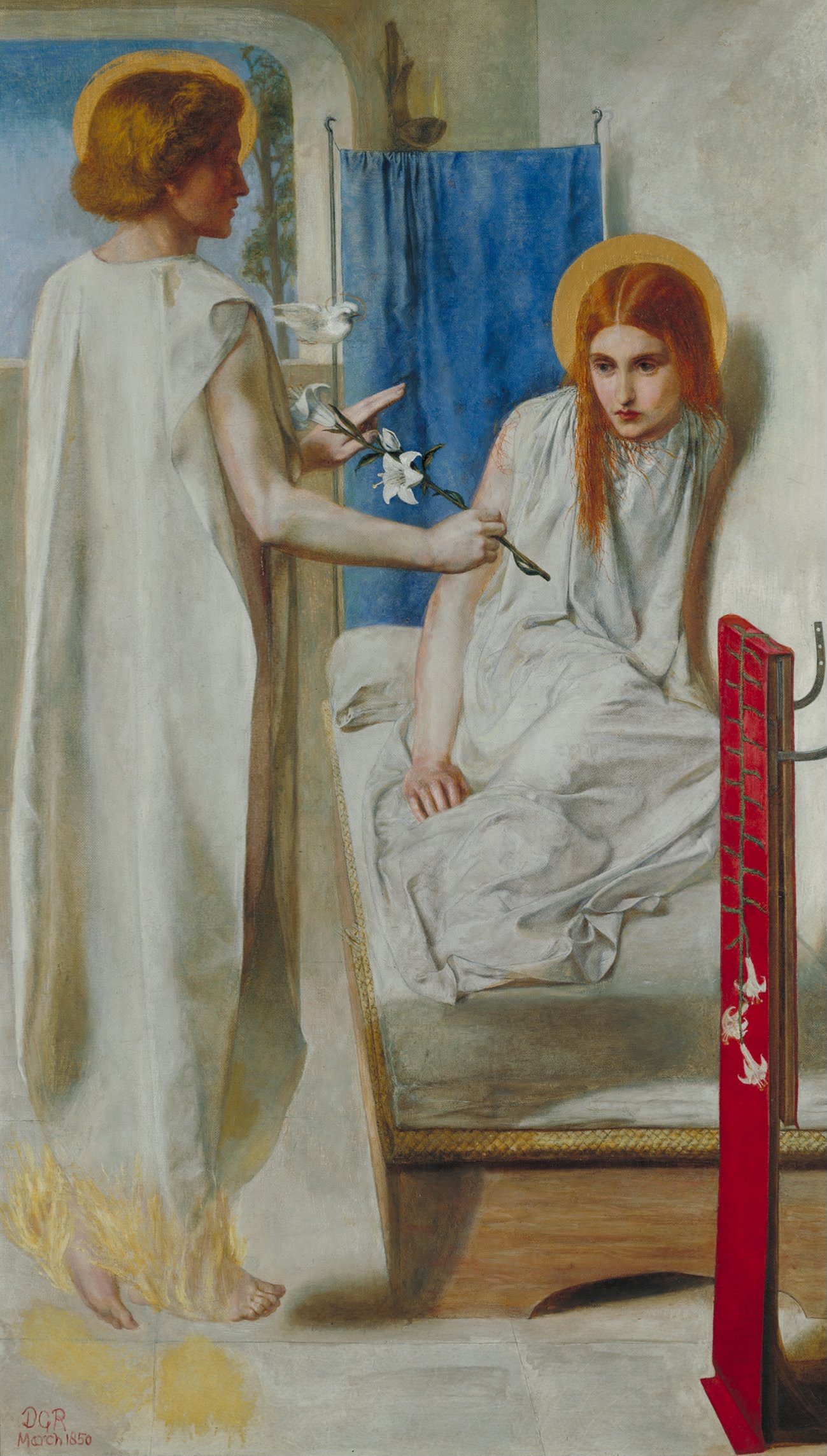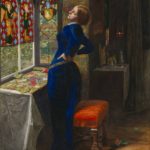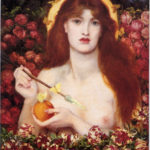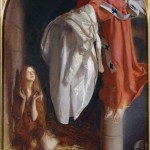Ecce Ancilla Domini! (The Annunciation) by Dante Gabriel Rossetti ~ 1849–50
Inspired by the work of early Renaissance artists such as Botticelli (1445-1510) and Fra Angelico (1387-1455), Rossetti sought in this work a radical reinterpretation of the Annunciation. Traditionally the Virgin was depicted in studious contemplation, reading a missal at a prie-dieu; but here Rossetti shows her rising awkwardly from a low bed, as if disturbed from sleep, while the Angel Gabriel presents her with a white lily. Both figures are dressed in white, a symbol of the virgin’s purity, and the angel’s role as the messenger of god is emphasised by the small white dove hovering beside him, signifying the presence of the holy spirit. Rossetti used several sitters for his figures, including his brother, William Michael, for the Angel and his sister, Christina, for the Virgin.
A companion piece showing the Virgin’s death was planned, but never begun. This partly explains the tall narrow shape of the picture, which was intended as part of a diptych. Rossetti intentionally restricted his palette almost entirely to white and the three primaries. The colour blue, symbolic of heaven, is traditionally associated with the Virgin and red symbolises the blood of Christ. Rossetti even sought a red-haired model for the Virgin’s head. The composition is carefully thought out: the vertical division of space, made by the blue hanging and the edge of the bed, falls almost on the Golden Section. The dove and the lily, with one bud still to break, move across this division and are the instruments of conception. Rossetti has written the date, ‘March’, at the bottom of the canvas, perhaps to signify the month in which the Feast of the Immaculate Conception is held. The original frame was also inscribed with Latin mottoes, copied from a brass rubbing owned by a fellow member of the Pre-Raphaelite Brotherhood, F.G. Stephens (1828-1907).
The picture was exhibited at the National Institution in 1850 and heavily criticised, partly for its didacticism. The critic for the Athenaeum wrote that it was ‘a work evidently thrust by the artist into the eye of the spectator more with the presumption of a teacher than in the modesty of a hopeful and true aspiration after excellence.’ (20 April 1850, p.424) Rossetti vowed never to exhibit in public again, but he continued to work on his picture until 1853, when it was sold to Francis McCracken of Belfast, an early patron of the Pre-Raphaelites, for £50.
Frances Fowle, December 2000
On Wikipedia:
Ecce Ancilla Domini (Latin: “Behold the handmaiden of the Lord”), or The Annunciation, is an oil painting by the English artist Dante Gabriel Rossetti, first painted in 1850 and now in Tate Britain in London. The Latin title is a quotation from the Vulgate text of the first chapter of the Gospel of Saint Luke, describing the Annunciation, where Mary accepts the message brought to her by the Angel Gabriel that she would give birth to a child (Jesus) by God.
Rossetti deliberately used a limited colour range for this oil painting. The predominance of white, symbolic of virginity, is complemented by vibrant blue (a colour associated with Mary, though notably not used in his The Girlhood of Mary Virgin in 1849) and red, for Christ’s blood. Lilies are traditionally the symbol of Mary in Italian Renaissance art, but they are also considered funereal flowers, indicative of Christ’s death.
Christina Rossetti posed for Mary but, as with her previous year’s modelling, her brother altered her hair colour: in this instance making it auburn to continue the red palette. William Rossetti posed for Gabriel.
This painting received mixed reviews. The most obvious break with tradition was Rossetti’s choice of placing Mary in bed – her long nightgown suggestive of a newly-wed bride – woken by the angel, who is normally depicted appearing as Mary prays. Also controversial were Gabriel’s lack of wings (the flames at his feet suggest a Classical influence) and his obvious nakedness, glimpsed through the side of his robe. Note also the dove’s halo, and the differences between Mary’s and Gabriel’s haloes, which may have arisen because Mary’s was painted in 1850, whereas Gabriel’s was not added until 1853.
Via: Tate Museum, Wikipedia







